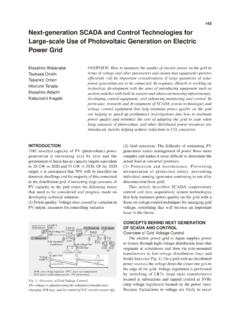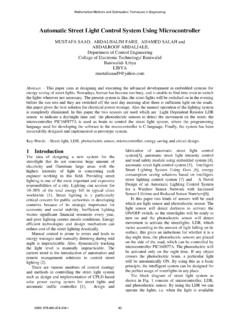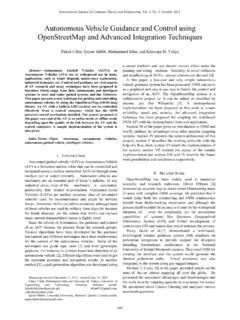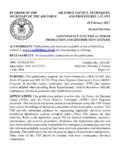Transcription of About the Author - Texas Instruments
1 3 About the AuthorBob Mammano has been recognized as a pioneer in the power electronics field with more than 50 years of experience in analog power control . He has also been called the father of the PWM controller industry resulting from his design of the first fully integrated PWM controller IC, the SG1524 in 1974. Mammano began his career with a physics degree from the University of Colorado in 1957. He learned power control as a circuit designer in the aerospace industry where he became frustrated by the limited availability of integrated circuits appropriate for his designs.
2 So with two other individuals he crossed the line from a user of semiconductor devices, to become a supplier by founding Silicon General in 1969, an IC manufacturing company located in Southern California. It was here that in addition to the first PWM IC his other firsts included a dual-tracking liner voltage regulator, power -supply supervisory circuits, and several power driver ICs. In 1981, he moved to the East Coast as part of a founding team for Unitrode IC Corporation (acquired by Texas Instruments in 1999). Here he continued to define more leading power control ICs, including the first current-mode controller as well as a landmark first complete PWM controller in an 8-pin package.
3 Mammano is a named inventor on 13 patents, has contributed numerous papers at technical conferences, represented the industry as a member of the power Supply Manufacturers Association, but most importantly, became heavily involved in the Unitrode/TI power Supply Design Seminar program, both in the preparation of topics and in their presentations world wide. In this position he became even more widely known as a technical speaker and respected educator, retiring in 2010. That is until deciding to become an Supply Design FundamentalsTechnology from the Unitrode/TI power Supply Seminar ProgramsIn 1977, the sales staff at Unitrode Semiconductor Corp.
4 A manufacturer of power transistors and rectifiers (and soon to include integrated circuits) convinced management that customers needed help in understanding how to use the company s newer products. Coincidently, this was shortly after the introduction of the first integrated circuit designed to implement switching power -supply control , Silicon General s SG1524, which was a pivotal point in power -supply development. It was also a time when the highest level of power technology gained from an EE degree at most universities did not extend much beyond simple linear voltage a goal of educating power -supply design engineers in the intricacies of switching- power technology, Unitrode initiated a series of public seminars that would soon become the go-to source for the latest in technical information both theoretical and practical.
5 The success of these seminar programs was further ensured by a plan to keep the topics technical, with a minimum of product promotion, and with presentations conducted by technical experts rather than marketers. Among the many subjects that first appeared in public at Unitrode seminars were current-mode control , phase-shift modulation, resonant switching, practical magnetic design, and power -factor correction, as well as many other now-commonplace design techniques. These seminars soon grew to a format that introduced a new program every 18 months, with each program containing six to seven original technical topics.
6 Each program was presented in public venues initially at major city locations in the , but eventually throughout the world. As of this writing, there have been more than 20 programs that have reached over 50,000 attendees, with many individuals returning to experience each new while the generation of all this technical information and design expertise has become a huge compilation of valuable engineering knowledge, its format of individual topics in individual seminar programs makes it difficult for the typical designer who is seeking answers to specific and unique issues to search and access.
7 It is this challenge to collect and organize the major elements of this store of information that has inspired this book. However, rather than merely reprint selected seminar topics, I have attempted to extract the subject technologies, tell why they might be important, and show how they should be applied, and to do so in an organized, developmental is hoped that by starting with the basic elements of switching power -supply design, and then expanding to include subjects of more advanced design and newer topologies, this presentation will be useful to both young engineers entering the power -supply field as well as a trove of ideas for experienced designers seeking references on specific subjects.
8 Where material from specific seminar topics has been incorporated into this book, a listing of the original seminar document will be found at the end of each chapter. This listing will give the individual publication number for each reference, which can then be accessed at , where xxx is the slup number provided with each reference. Finally, I need to include a note of appreciation for all who have made this book possible:First, to Texas Instruments Incorporated, for granting access to all the past and current power Supply Design Seminar materials and in supporting the development of this book.
9 I cannot speak too highly of the personnel resources, without which this book could never have been completed. These included:Tim Goodrow from TI s Product Marketing Group, who was the primary manager of the team of talent needed both to insure that my writings would be adequately descriptive, technically accurate, and fully inclusive, as well as goading me on to meet scheduled completion Kollman, reactivated out of retirement from a career as head of TI s Customer solution Group, who became my chief technical editor as well as contributing the chapter on power Supply Lenox.
10 TI s talented graphic artist who took on the task of adapting all my collection of pictures from past seminars, hand-drawn sketches and scanned images, into the graphic format for all the hundreds of illustrations needed for this Schweber, Engineer/ Author /Editor, Jaffa Engineering, whom TI con-tracted to insure that my writings would be legible and understood (no small task!). It is to him that we all have to thank if we have succeeded in making this text flow readably Somers, Visual Graphics/Illustrator, who actually created a book out of my accumulation of Word drafts.

















